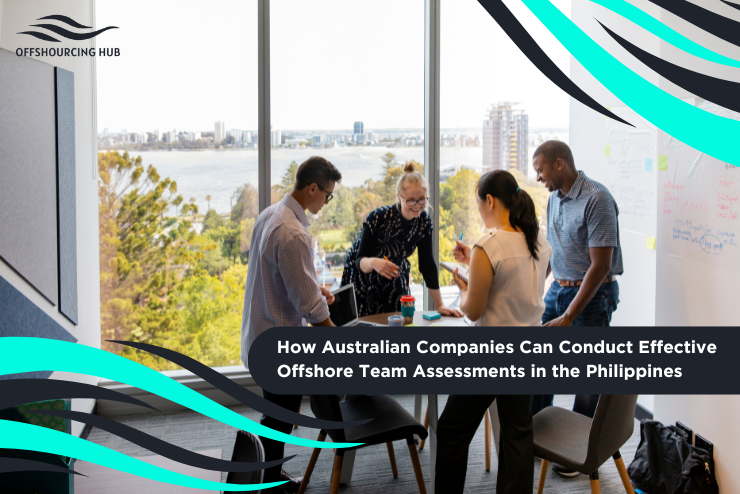How Australian Companies Can Conduct Effective Offshore Team Assessments in the Philippines
- Sebastian Elliot Osborne

- Jul 28, 2025
- 8 min read
Updated: Aug 6, 2025

Offshore teams in the Philippines aren’t a budget shortcut anymore, they’re a serious part of how modern Australian companies operate. What used to be seen as a low-cost staffing option has become a proven way to scale operations with talented professionals who work just as hard, communicate clearly, and understand the standards expected by Australian businesses.
There’s a natural alignment between Australian and Filipino work cultures. English fluency, strong communication skills, and a shared sense of professionalism make it easier to collaborate. Many businesses are now realising that their offshore team isn’t “separate” — it’s simply an extension of their existing workforce, which makes having a consistent and fair offshore team assessment process more important than ever.
According to the International Trade Administration (2023), offshoring to the Philippines can reduce labour costs by up to 60%. But here’s what that actually means: if you're running a mid-sized digital agency in Sydney or Melbourne, the money you save from hiring offshore doesn’t just sit idle, it can be redirected into better tools, campaign spend, client acquisition, or upskilling your in-house staff. For growing businesses, that shift can mean moving forward six months faster than planned.
Performance assessments aren’t just a formality. Done right, they create the structure your team needs to stay aligned, feel supported, and deliver consistent results. Done poorly or worse, skipped altogether, they lead to silent attrition, miscommunication, and a growing gap between what’s expected and what’s actually being delivered.
In this article, we’ll explore the common risks Australian companies face when managing offshore teams, and more importantly, the practical steps you can take to assess and strengthen performance from day one.
What Goes Wrong Without Proper Assessments

Plenty of businesses start off strong with offshore hiring. Then three or six months in, they’re frustrated. Tasks are being completed, but quality’s dropping. Deadlines slip. Offshore staff feel out of the loop. Onshore staff complain they’re picking up the slack. And no one’s quite sure why.
Let’s break that down:
Expectations aren’t aligned. Offshore hires are often expected to "figure it out" with vague instructions and shifting priorities. Without a clear scope or measurable goals, staff end up second-guessing what's most important. Over time, this leads to delays, duplicated work, or inconsistent output, all of which could’ve been avoided with better upfront guidance.
Cost becomes the focus. Businesses get so caught up in savings that they forget to check whether the work meets their standards. It’s easy to fall into the trap of “as long as it’s done cheaply, it’s working,” but poor quality always finds a way to cost more, whether through rework, brand damage, or missed opportunities. If offshore work isn’t held to the same standard, the long-term value disappears — especially in fast-growing setups like offshore outsourcing in the Philippines, where volume and pace can mask performance gaps.
Feedback dries up. Timezones make it harder to catch up. Weeks pass without real conversations. Before long, offshore staff stop asking questions, and small misunderstandings quietly pile up. Without ongoing feedback, even high performers can lose momentum or veer off track.
Double standards form. Onshore teams have structured reviews, training, and support. Offshore teams? Just emails and tasks. This divide creates resentment on both sides, local staff feel they’re carrying more weight, while offshore staff feel disconnected and undervalued. It becomes harder to foster shared ownership when expectations and support aren't equally applied.
No review process in place. Without regular check-ins, issues go unnoticed until they become bigger problems. Projects stall, quality dips, and deadlines start to slip, but no one’s flagged it because there was no system to catch it early. A basic review rhythm doesn’t just catch problems, it gives people confidence that their work is being seen and supported.
How to Assess Offshore Performance Without Making It Complicated

You don’t need a complex system or expensive software. What you need is a consistent structure that sets expectations early, maintains visibility over work, and fosters trust between teams. Most performance issues stem from a lack of clarity, not capability — and this applies just as much to quality assurance offshoring in the Philippines as it does to any other business function. Without structure, even the most capable offshore professionals can feel unsure of what "good" looks like.
Set Expectations Early and Make Them Clear
Before assigning even the first task, make sure the offshore team member knows what’s expected, not in broad strokes, but in operational terms. Define what output looks like in a normal week. Explain who reviews the work, how quickly they’ll receive feedback, and what response times are considered reasonable.
For example: if you’re hiring someone to manage your content schedule, don’t just say “publish three blogs per week.” Clarify the full workflow: who writes the brief, who approves the draft, when it’s due, what tools they’re using to track tasks, and what happens if deadlines are missed.
A Sydney-based digital agency I worked with ran into delays simply because the approval process wasn’t clear, each piece got stuck in limbo between marketing and leadership. Once they created a simple content workflow in a shared doc, things moved fast. They got back six weeks of lost time, without adding a single new hire.
Create a Simple, Repeatable Review Process
Too many businesses treat offshore teams as a “set and forget” function, which almost always backfires. Even the best people drift without regular feedback.
A monthly check-in and a quarterly review are enough to keep things on track. You don’t need complex tools — just something that logs performance over time. Whether it’s Trello cards, ClickUp dashboards, or a Google Sheet with a few key questions, the goal is consistency.
These check-ins give offshore staff a chance to reflect, flag blockers, and raise questions they might not feel comfortable emailing out of the blue. And for you, it keeps expectations and delivery aligned. One of the clearest signs of a review gap is when a task that used to take two days suddenly takes five, and no one noticed until the deadline passed.
Don’t Rely on Numbers Alone
It’s easy to get misled by metrics. You see a report that says your VA completed 120 tasks last month and assume everything’s running smoothly. But numbers don’t tell you if the tasks were meaningful. They don’t show if someone is quietly struggling, or if the work is being rushed just to tick boxes.
In one project, I worked with an ecommerce business in Brisbane that had a highly efficient VA or so it seemed. She was finishing all her assigned tasks quickly, but rarely added input or asked questions. After a few honest review conversations, we realised she didn’t fully understand half the briefs and was afraid to speak up. Once the team clarified expectations and encouraged more interaction, her confidence and quality of work — improved dramatically.
Involve Onshore Managers
It’s easy to assume that offshore teams can just “slot in” and work independently. But without connection to your local team, they often end up working in silos, unseen and unsupported. That’s a missed opportunity.
When onshore managers are involved, it sends a clear message: the offshore team is part of the business. They’re not just a separate function. Simple habits, like fortnightly video check-ins or casual Slack conversations, make a real difference. They keep communication open and give offshore staff a better sense of where their work fits in the bigger picture.
From a legal and compliance angle, it’s important to treat offshore assessments with the same professionalism you’d apply locally. Philippine labour laws require fair treatment, and reviews must be based on clear criteria, not vague impressions or assumptions. If you’re working with an outsourcing provider, ask whether they include local HR or legal guidance as part of their support. It helps ensure your process is compliant and respectful.
The Practical Side of Managing Offshore Staff

The simplest way to approach offshore performance is to stop treating it like a separate system. If you already have a structure for managing remote staff in Australia, weekly check-ins, KPIs, project timelines — apply the same structure to your team in the Philippines. No need for a different set of standards. Consistency is what keeps things fair, scalable, and professional.
Too often, I’ve seen businesses overthink offshore management. They either over-monitor (checking in constantly because they don’t fully trust the setup), or under-manage (thinking the provider will handle everything). Both create friction. An offshore team in the Philippines isn’t a group of passive freelancers or background support — they’re part of your operations. If you treat them as such, they’ll rise to that standard.
Filipinos, by nature and culture, tend to avoid direct confrontation. It’s not a lack of confidence — it’s a deep respect for hierarchy and harmony. In a Western context, where employees might speak up freely when something doesn’t make sense, a Filipino team member may stay silent — even if they’re unsure about a task or struggling with workload. I’ve worked with teams where confusion dragged on for weeks simply because no one felt comfortable saying, “I don’t understand.”
The lesson: be specific, and frame feedback as a support tool, not a criticism. Use examples. Explain why something needs to be done differently, and give people a safe space to clarify expectations. Over time, this builds trust and trust improves performance.
If you’re partnering with a provider in the Philippines, don’t assume all people management will happen in the background. It’s worth asking them: – Do you have HR staff who can sit in on reviews if needed? – Can you help mediate cultural or communication gaps? – Are there local compliance steps I should be aware of in conducting formal assessments?
Lastly and this is key — always review two things: output and process. I’ve seen teams celebrate a strong month of deliverables, only to discover that the way the work was done relied on shortcuts, unclear briefs, or last-minute scrambling. It may have “worked” once, but that kind of process doesn’t scale. You can’t build a reliable team on adrenaline and guesswork.
Look at the outcome, yes — but also ask: – Was the brief understood? – Was communication smooth throughout the task? – Were deadlines met without unnecessary pressure or rework?
When you balance clear structure with cultural awareness, and stay engaged without micromanaging, you’ll find that your offshore team isn’t just competent, they become dependable. And in any business, especially one aiming to grow, dependability is where real value lives.
Your Offshourcing Advice

Good offshore teams aren’t built on pressure, they’re built on structure. Clear roles, consistent communication, and a simple review process matter more than any fancy tool or micromanagement habit. When people understand what’s expected and feel supported along the way, they’re far more likely to deliver consistent, high-quality work. You don’t need to hover, you just need to stay engaged.
Australian businesses that treat their offshore staff like genuine members of the team tend to see stronger outcomes across the board. Retention improves. Accountability strengthens. And teams start to run with more autonomy, because they’re operating within a framework that supports good decisions and steady output. Offshore success doesn’t come from control; it comes from clarity.
If you want your offshore operations to succeed, start by making performance assessments part of your culture. Not a backup plan when things go sideways, but a steady rhythm built into how your business runs. That simple shift — from reactive to consistent, is often what separates a functional offshore team from one that actually adds long-term value.





Comments